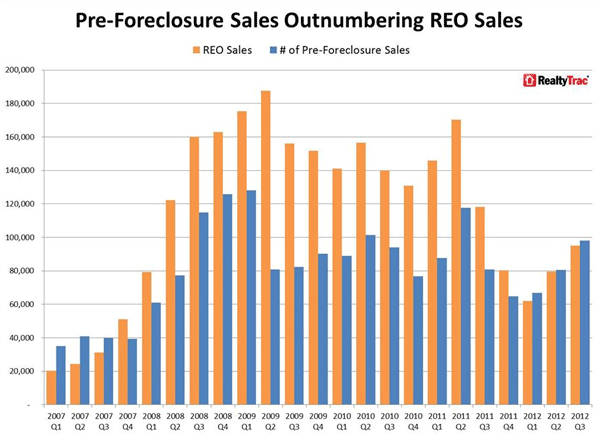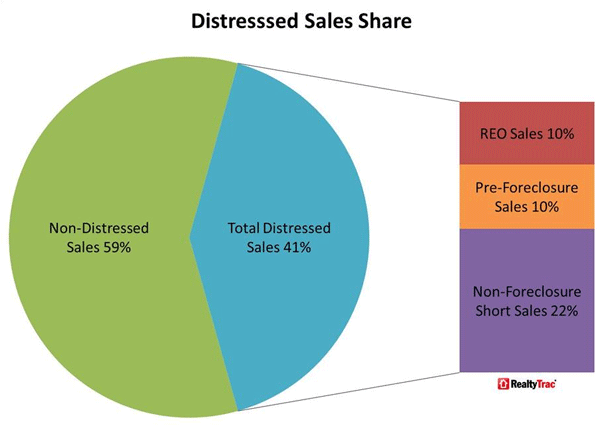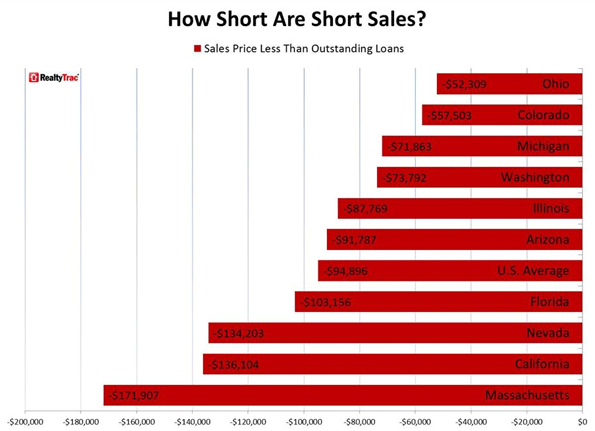Blog

Short Sales Outpace REO Ahead of Tax Relief Expiration
Just as they had a year earlier,rnforeclosure and pre-foreclosure sales made up nearly one-fifth of thernresidential home sales in the third quarter of 2012. According to RealtyTrac’s Q3 U.S.rnForeclosure and Short Sales ReportTM released on Thursday, 19 percent ofrnhome sales nationally were either bank inventory (REO) or properties pre-foreclosure. These are usually short sales in which the bank agrees to accept less than thernfull mortgage balance to release its lien. rnThis share is identical to that in the third quarter of 2011 and onlyrnone percentage point lower than in the second quarter of 2012. </p
There were a total of 193,059rnU.S. properties sold through short sales or out of bank-owned inventories (REO),rnup 21 percent from sales in the second quarter and three percent lower than onernyear earlier. Unlike in earlier quarters shortrnsales outnumbered REO sales by 98,125 to 94,934. Pre-foreclosure sales were 22 percent higherrnthan in both the previous quarter and in the third quarter of 2011. Sales of REO increased 19 percent from thernprevious quarter but were still down 20 percent from the third quarter of 2011.rn</p
 </p
</p
RealtyTrac reports that anrnadditional 22 percent of residential sales were short sales of properties forrnwhich the foreclosure process had not yet begun. This brought the market share of distressedrnproperties to an estimated 41 percent, an increase of 15 percent from thernsecond quarter and 17 percent from one year earlier.</p
 </p
</p
Distressed homes sold at an average discount of 32 percent fromrnthe price of a market sale. The discountrnhad been 29 percent in the second quarter and 31 percent in the third quarterrnof 2011. The discount on short sales wasrn27 percent compared to 25 percent the previous quarter and 19 percent a yearrnearlier while the discount on REO was 38 percent, 5 percentage points higherrnthan the second quarter but lower than the 39 percent discount one year earlier. </p
The average sales price of a short sales was $191,025. Banks forgave an average of $94,896 on pre-foreclosurernshort sales and $82,312 per short sale of homes that were not in foreclosure. REOs sold for an average price of $161,954,rndown 7 percent from the previous quarter but up 7 percent from the thirdrnquarter of 2011. </p
 </p
</p
“The shift toward earlier disposition of distressedrnproperties continued in the third quarter as both lenders and at-riskrnhomeowners are realizing that short sales are often a better alternative thanrnforeclosure,” said Daren Blomquist, vice president of RealtyTrac. “However, thernscheduled expiration of the Mortgage Forgiveness Debt Relief Act at the end ofrnthis year could stifle this trend toward short sales. If that law expires asrnscheduled, homeowners who agree to a short sale could see their income tax jumprnsignificantly because the portion of the unpaid loan balance not covered by thernshort sale proceeds will be considered taxable income in many cases.</p
“The prospect of being taxed on potentially tens or hundredsrnof thousands of dollars in additional income may motivate more distressedrnhomeowners to forgo a short sale and allow the home to be foreclosed,”rncontinued Blomquist. “Additionally, if the mortgage interest deduction isrneliminated due to the fiscal cliff quagmire, it would give many underwater andrnotherwise distressed homeowners one less reason to hang on to their homes.” </p
Short sales took an average of 359 days to sell afterrnentering foreclosure, up from 319 days in the second quarter and REOs were soldrnon average 186 days after being foreclosed, up from 195 days in the previousrnperiod. </p
Georgia had the highest percentage of distressed sales, a 38rnpercent market share. This was down fromrn41 percent the previous quarter. Pre-foreclosurernsales were up 40 percent and REO sales 4 percent. Non-foreclosure short sales increased 32rnpercent on an annual basis and accounted for an estimated 18 percent of allrnresidential sales in the third quarter.</p
Foreclosure related sales accounted for 36 percent ofrnresidential sales in California and 34 percent in Arizona despite annualrndeclines of 12 percent and 28 percent respectively. In both cases REO sales declined by largernamounts (37 percent in California and 49 percent in Arizona) while short sales ofrnboth pre-foreclosure and non-foreclosure properties were up significantly.
All Content Copyright © 2003 – 2009 Brown House Media, Inc. All Rights Reserved.nReproduction in any form without permission of MortgageNewsDaily.com is prohibited.
Latest Articles
By John Gittelsohn August 24, 2020, 4:00 AM PDT Some of the largest real estate investors are walking away from Read More...
Late-Stage Delinquencies are SurgingAug 21 2020, 11:59AM Like the report from Black Knight earlier today, the second quarter National Delinquency Survey from the Read More...
Published by the Federal Reserve Bank of San FranciscoIt was recently published by the Federal Reserve Bank of San Francisco, which is about as official as you can Read More...

Comments
Leave a Comment